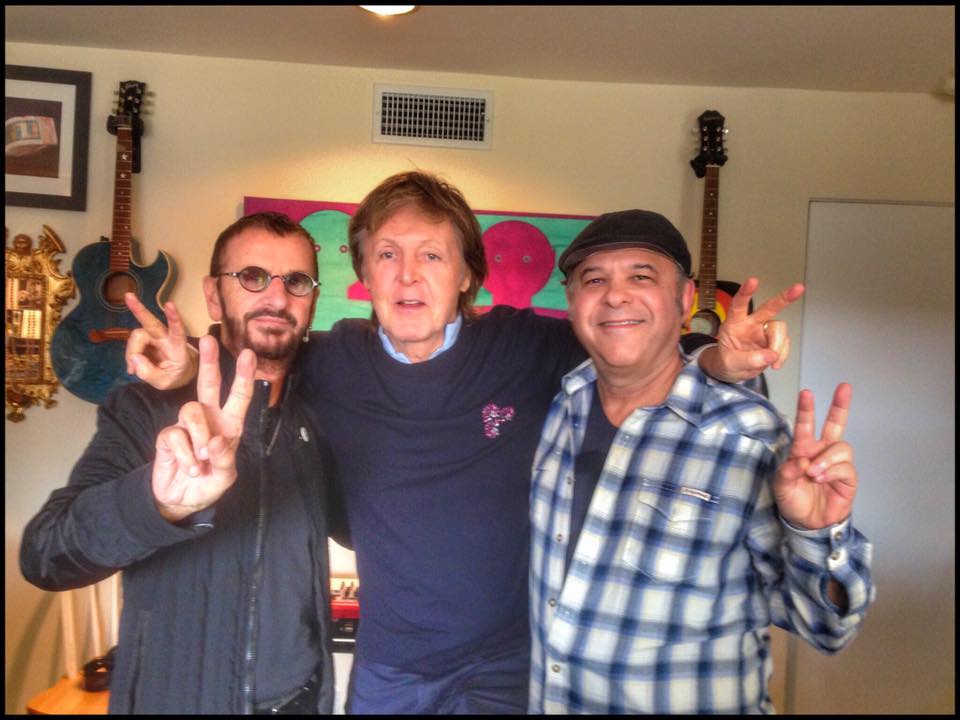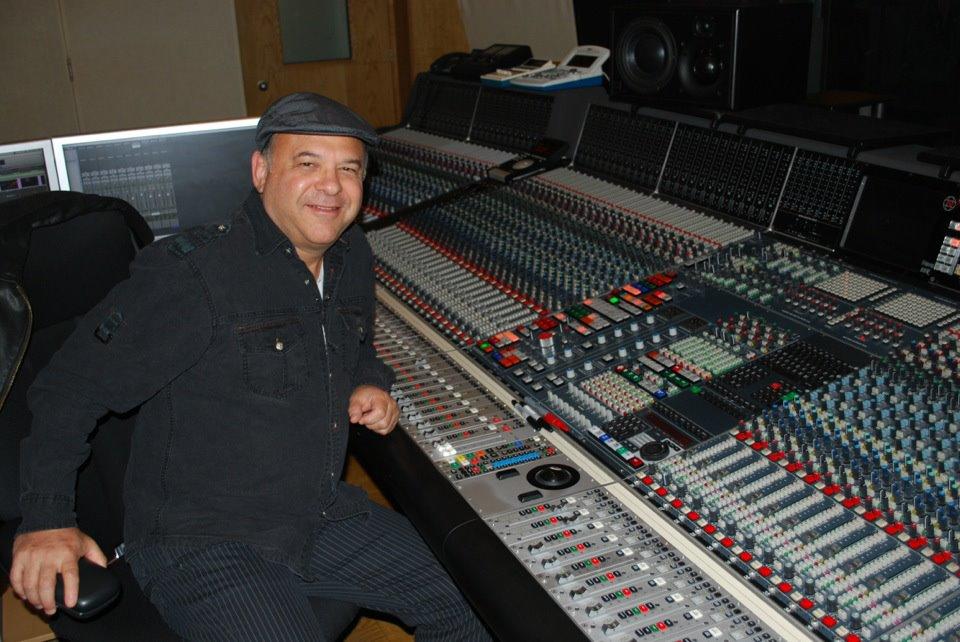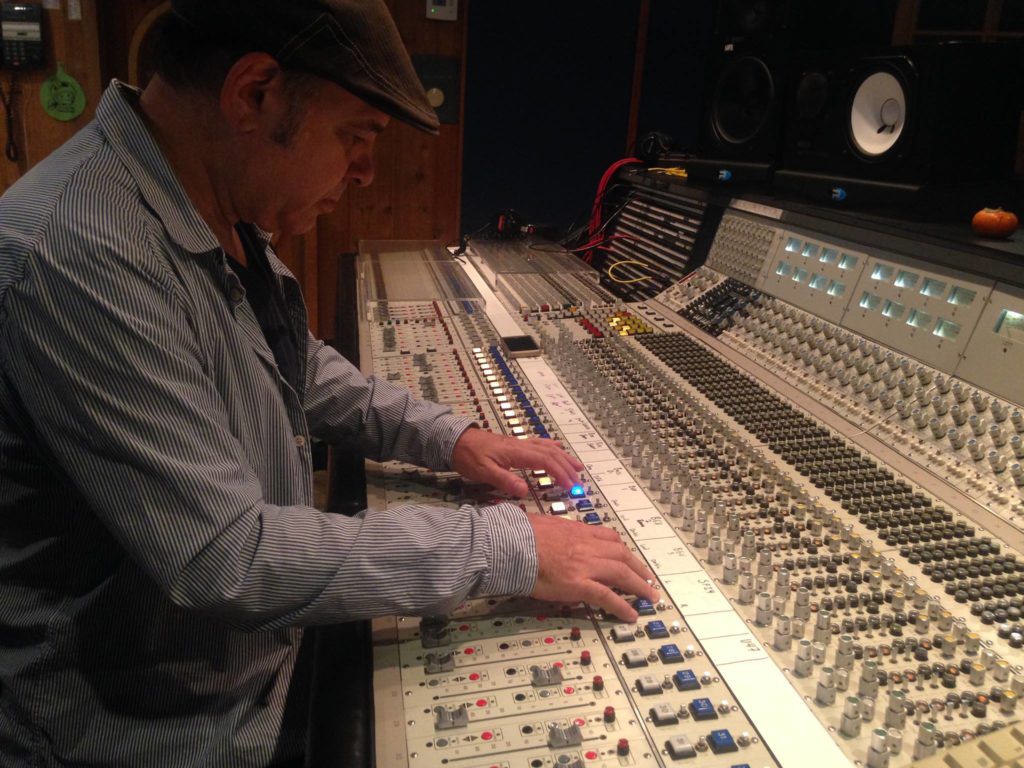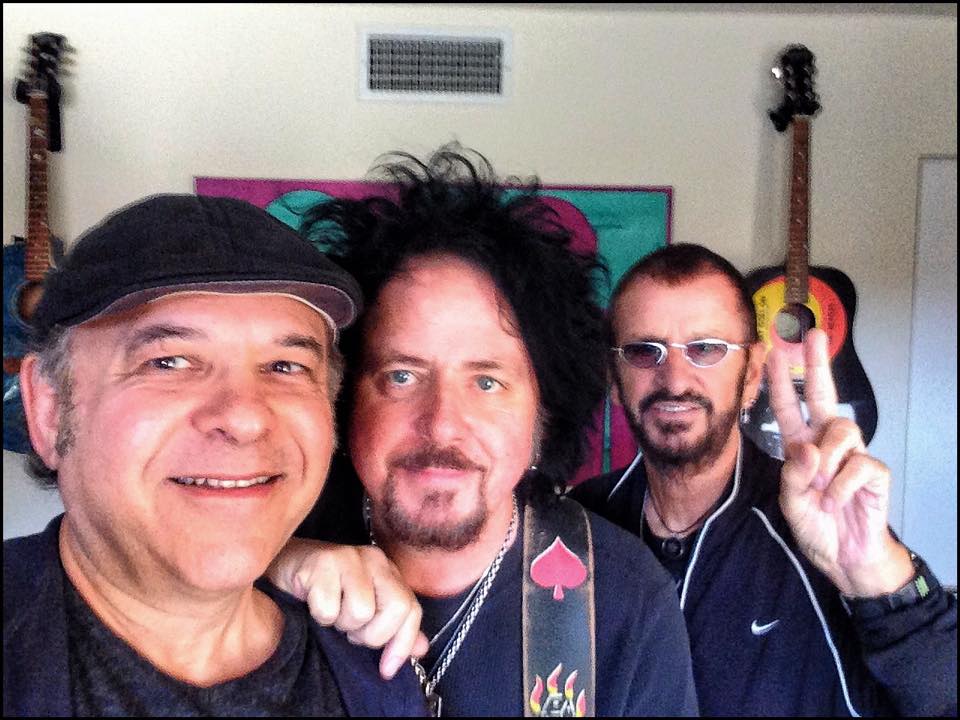Stop Struggling for Perfection: Bruce Sugar on Working with Ringo Starr, Paul McCartney, Joe Walsh, Ozzy & More
They say you should never meet your idols, but recording and mixing engineer Bruce Sugar would surely disagree.
Growing up near Atlantic City, Sugar was a bright-eyed kid who was introduced to music early on and spent his childhood practicing piano. Then, one day in 1964, he heard a sound like no other on The Ed Sullivan Show and was captivated. The Beatles had journeyed stateside, conquering late night television.

Bruce Sugar in the studio with The Beatles’ Ringo Starr and Paul McCartney. Starr’s latest, Give More Love was released in late September.
Of course, there’s no way a starstruck young Bruce Sugar could have ever predicted that he would one day travel across the country and end up in the studio with two of Liverpool’s finest.
Even audio engineering itself wasn’t exactly part of Sugar’s original plan. He had attended the University of Colorado Boulder where he studied Environmental Conservation and City Planning. But music reared its irresistible head again and he took his first audio gig right out of college. In a mobile recording studio that an electrical engineer friend built and operated, Sugar learned his craft one live-recording pit stop at a time.
Then, in the early ‘80s, following what was supposed to be a “quick” trip to Tennessee, Sugar ended up working at Quad Studios Nashville, located on Music Row. Five years later, he made his final move to Los Angeles where he met a longtime studio executive named Rose Mann and was offered an assistant engineering role at Baby’O Recorders, an opportunity that eventually led him to become the independent engineer he is today.
Eventually, he found himself working with some of his heroes from a younger age: Ringo Starr, Joe Walsh, Paul McCartney, Ozzy Osbourne, Elton John, and credits them with his continued growth as an engineer.
“I [learned] a lot when I started with Ringo and Joe Walsh about the importance and magic of spontaneity,” he tells me. “Before I was working with them, I was a little more on the side of someone who would struggle to find perfection. When you realize that doesn’t exist, I think it frees you a bit. There is no perfection; you’ve just got to trust your instincts.”
Below, find out more about Sugar’s decision to mix Ringo Starr’s new album Give More Love completely in-the-box, the re-recording of the classic “Back Off Boogaloo,” and how he discovered one of his favorite vocal mics.
You’re still based in LA, right?
I am, yeah. I’ve worked out of here since ’85. When I first got here, there [was] a tremendous amount of professional studios in Los Angeles and the home studio thing was just a dream in some people’s minds. Over the years, things have progressed to where everyone has a home studio. Some are better than others.
I have a little mix room—just a spare bedroom in my house—that I’ve outfitted with a full Pro Tools system. I’m pretty much in-the-box, but I have a few pieces of outboard that I use. I’ve got some Retro Instruments stuff and Lexicon outboard. Ringo has his own home studio that we built. It’s just easier for him to get out of bed and walk over to the studio rather than drive around LA.
Is Ringo’s studio pretty close to where you are?
I’m in Hollywood Hills and Ringo is in Beverly Hills so I just go over there. It’s very unassuming. His studio is in one of his guest houses. His drums are in a bedroom. [Laughs]
I noticed that setup in the Ringo Rama documentary from a while back. It doesn’t seem like a typical live room. What was behind the decision to have the drums in there?
It wasn’t much of a creative decision or technical decision. It was more of that was the only place to put them in that particular situation. Once we put all of the mics up and start recording them, they sounded great. If there were some problems, I probably would’ve done some treatment to the room, but it sounded really good.
The thing about Ringo that maybe a lot of people don’t know is, when he started out they only had one or two mics [recording his drums]—three at the most—so his internal balance is the best I’ve worked with.
I put up some Neumann U 87s as room mics and it sounds amazing. Then, I just fill it in with some kick and snare. You don’t need much because, like I said, some drummers’ internal balance is so bad you need mics everywhere to rebalance it, but Ringo’s balance is so great that it just seems to work in that room. He could probably play anywhere and it’ll sound good.
Absolutely. Maybe this is just a rumor but is it true that Ringo only likes to do three takes at most?
That’s pretty much true nowadays. He’s been doing it so long that he knows what he wants to do. I think he appreciates the magic of spontaneity, which a lot of people brush aside, but he’s a big believer of that, as am I.
Sometimes the first or second go at it has that magic because you’re not thinking about things too much—you’re acting emotionally—which really is what it’s about.
Given the editing capabilities we have today, if there’s one little thing wrong, it’s easy to fix now. If he does a great take and he misses a beat here or there, it’s easy to fix, so it’s true he’ll only do one or two takes usually.
Most legendary artists seem like they have enough experience to not overcomplicate the process.
Some people are more perfectionists than others—or, at least, in their minds they are. Generally, most people with a long career in this business don’t really need to get too crazy with multiple takes and stuff. But I’ve heard from others that some people will work you to death.
That’s one of my rubs with today’s music: Everything needs to be so perfect. Some of the emotion gets filtered out of a performance when you time and pitch correct everything. I do a bit of it too, it’s a part of modern production technology. But I think there’s a line where you have to let certain things slide in the name of humanity. Everything doesn’t have to be perfect. [Laughs]
Very true. So, when it comes to the type of gear you routinely use, has it changed album to album over the years?
It depends on the situation and the environment. If I’m in a home studio and they only have a limited amount of mics, then I’ll work with that situation. If I’m at Capital or EastWest, they’ve got every mic known to man.
Sometimes I’ll put up a lot of mics, especially for ambient stuff. I like to create space with microphones. In a big studio, I’ll normally put up quite a few room mics to capture the ambience of the room. That’s what you’re paying for.
Today, with unlimited tracks, it doesn’t really matter. You just put some mics up and you either use them or lose them. It really depends on the situation, the type of music, and a lot of other factors.
I pretty much go with gear that I know works: The tried-and-true 421s, 57s, 414s, 187s, 1176s, LA-2As, etc. There’s a reason every studio has those—because they work. [Laughs] There’s a lot of great boutique stuff out there too.
Is there anything unique or different that you used on Ringo’s new album, Give More Love?
Yeah, here’s a cool story: A couple years ago, I was in England at Ringo’s old home. There was a storage area above the studio. I was looking for some cables or something and I came across this old box all duct taped up. I opened it up and it was a vintage M 49 in pristine condition. It had the serial number 189, I think— a really low serial number.
I went to Ringo and I said, “What’s the deal with this mic?” He goes, “Oh, yeah. I forgot about that. That was from Tittenhurst [Park].”
When he lived with John Lennon, they had a studio [called Ascot Sound Studios]—that’s where they did Imagine. I’m not sure what that mic was used for there but we had it shipped over here. I still run it at 220V. I got a converter because I didn’t want to change the power supply. I used it on all of his vocals. I didn’t use any EQ on his vocals. It’s an amazing sounding microphone.
That’s so cool. You’ve worked at some of the most famous studios in the world. I know that growing up you were a Beatles fan, so it must’ve been fantastic to work in Abbey Road Studios.
Abbey Road was amazing. I actually mixed an Ozzy Osbourne record there. Another great studio in London that I got to work in was Mark Knopfler’s studio called British Grove Studios. It’s an amazing place. You don’t really hear a whole lot about it because I don’t know if it’s open to the public. I know he rents it sometimes, but it’s really fun. In New York, I’ve worked in some of the top places but most of them are closing down now. Avatar was just sold to Berklee School of Music.
What are your thoughts on that?
It’s the economics in Manhattan. The real estate is so, so expensive there. It’s a shame.
Luckily, with Berklee, I’m sure they’ll keep some of the studios there. I’m not sure what their plans are but at least it’s not going to become condos, which is what happens to a lot of old studios.
Didn’t you attend Berklee at some point?
I went to Berklee for one year. At one point in my confused youth, I thought jazz might be a good idea. [Laughs]
I took piano for a year. It was a really tense year but I’m very glad that I spent the year at Berklee because they basically taught me the language of music.
It seems like many successful people that go to Berklee only stay for about a year anyway.
It’s just too much learning. I’ve talked to a few Berklee grads and they were like, “Well, it took me four years to learn all of that and ten years to unlearn it.” [Laughs]
You’ve played piano on a few records and on late night TV, so maybe it was worth it.
In the studio, I get by on stuff. Obviously, I’d rather hire the likes of Benmont Tench, Jim Cox, or numerous other amazing keyboard players here in town. But, once in a while, I’ll do a synth pad—I can hold my own doing that. Ringo is really generous. He has let me play in the band to do ancillary parts or string parts. It’s a lot of fun.
From start to finish, how long did it take to record and mix Give More Love?
It was pretty sporadic. We probably worked on it for nine months on and off. Then, in February of last year, he was like, “I got two or three months at home so let’s finish it up.” From March to May, we got real serious about it and did the majority of the work in those months and then I mixed it.
He doesn’t spend 10-hour days working on stuff. We’ll work over at his place for three or four hours and then I’ll go home. If I have to do some editing, I’ll do it at my place, but it’s a very relaxed pace. There are no deadlines or anything like that. His projects are free of any worry about record company intervention. They basically give him free reign.
How many of the numerous guest musicians on the record actually came to the studio this time around?
The only stuff flown in were a few guitar solos Peter Frampton did. He’s in Nashville, so he sent in a few things. Pretty much everybody comes over. The room is not large enough to record a six-piece band so there’s definitely a lot of overdubbing. It’s all there pretty much.
That must be a lot more fun.
Ringo loves the process and the people coming over. The human interaction—that’s what it’s all about.
He’s a little isolated in his life because of his fame. It’s a good excuse for people to come over and socialize. It’s a good time.
So, when it comes to mixing, you said before that you largely work in-the-box at this point. What was your approach on Give More Love?
This is the first album of Ringo’s that I did completely in-the-box. Nowadays, when I’m working on a track, I’m always mixing as I go. His system basically mirrors mine, so we have the same version of Pro Tools and plug-ins. It’s pretty seamless back and forth. I’d work on it at my place a bit and then finalize the mixes over [at Ringo’s studio]. I’m happy with the way it turned out.
I’ve mixed other projects in-the-box. The main thing is the quality. At the beginning of the year, I bumped up to Pro Tools 12.8—I had been using 10 previously—and I noticed a huge difference in everything. I recorded it in 96 kHz. The tracks are so much more open. The quality of plug-ins, especially from UAD, is so great.
Do you have any favorite plug-ins?
I come from the old, analog school so a lot of my go-to plug-ins are the ones you’d expect. I love the 1176, LA-2A, Neve 88RS, and 1073. The EMT 140 plate reverb is great. I have some outboard gear from Lexicon but I have their software versions too. They’re basically the same thing. Eventide has also released a whole package of their stuff. The amount of tools available software-wise now is ridiculous. [Laughs]
I get tracks from people that want me to re-mix stuff that maybe some younger guys have done. When I look at the sessions, they so overuse plug-ins. You don’t need 10 plug-ins on every track. Less is more.
I noticed that Ringo is often credited as co-mixer on his albums. How hands-on is he when mixing?
We just share that. He’s in the room making comments. I do 98% of the mixing but it’s really great when we work together because while I’m looking at the minutia, Ringo is a great big picture person. He just has a larger overview of the songs. He has a lot of input to what the mixes are. His music instincts are really good. He’s done it for so long that he knows what he likes.
There are so many incredible musicians on this album. How were those guest sessions, such as the ones with Steve Lukather?
Yeah, those were great. Steve came by with many ideas. He wrote “We’re on the Road Again” and the ballad “Show Me the Way.” For “We’re on the Road Again,” it started with a guitar lick and then a sort of structure came about with him and Ringo putting down guitar and drums together.
Lukather is a complete genius in the realm of studio recording. I think the guy has played on more records than anyone in history. If not, he’s near the top of the list. He’s always been a hero of mine. To work with him was a dream too.
When it comes to working with someone like Joe Walsh or Paul McCartney—artists that we’ve heard on so many records—what goes into achieving and maintaining their “signature sound”?
For the sessions with Paul, his assistant called and said, “You’ve got to just have a bass amp there.” So I rented out a B15 and he came with his Höfner. He actually came over on his day off. He was working on his own album in L.A. and was nice enough to come by on a Sunday to help Ringo out. He worked hard too. Those songs were not the easiest in Ringo’s playbook. He took his time to do it right—it was great.
I read that Paul and Ringo hadn’t been in the studio together for seven years.
Yeah, in the studio, they hadn’t really done anything since Y Not. They’ve been together at some events and playing a few tribute things but not in the studio.
It seems like you’ve worked with so many heroes. Is there anyone that you’d still like to work with?
I’ve done one or two sessions with Elton John but I’d like to do more with him. He’s one of my idols as well.
I’m so curious to hear the story behind the re-recording of Ringo’s old song “Back Off Boogaloo.”
That’s an interesting story. He had most of his stuff shipped here because he’s living in Los Angeles full-time now. One of his assistants was going through a box he had in storage and they found a 1/4” reel of tape. When they put it on, and it was Ringo singing “Back Off Boogaloo.” At the beginning of the track, you’ll hear it, him from 1971.
So, Ringo was like, “Man, this is cool. It’s got a cool echo on it. It’s real vibey. I want to have Jeff Lynne do a track to this.” He sent Jeff that snippet—it was only a minute long, it wasn’t the full song. So, Jeff went to work, he sent us a track a couple of weeks later, and he didn’t really incorporate that piece. It was basically a new track with him programming the drums and playing guitar and bass. It was a cool track but it really had nothing to do with what Ringo’s original idea was. I told Ringo, “Let me work with it a bit.” I was able to marry that little piece to Jeff’s track and then it evolved a bit.
It was kind of like “Strawberry Fields Forever” in that I had to speed one up and slow one down and match the pitches. Then, we took Jeff’s programmed drums off and Ringo played drums on it, which really brought it alive. And then we got Joe Walsh to play on it, which was nice; he played some really great slide.
Ringo re-sang the whole track with this new [instrumentation] and pieces of the original tape. Then, I took this weird, extracted vocal from the [original] single, which was all phase-y and weird sounding, but I was able to time-align it to his new vocal and it became like a background part. So, it’s basically three generations of Ringo on one track. I dig it. I think it’s an interesting bonus track.
Definitely. Any other interesting projects coming up?
I have a few in the works, but nothing I can talk about right now. We’ll see what develops. Being independent, you’re always waiting for your next phone call. It’s a part of this life. I’ve been fortunate. Nowadays, I don’t sweat the time off too much, I just try to enjoy it.
Please note: When you buy products through links on this page, we may earn an affiliate commission.










[…] This article can be found on SONICSCOOP.COM […]